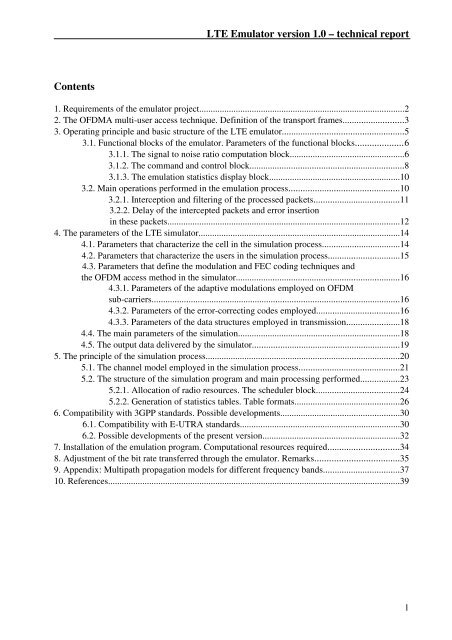LTE Emulator
LTE Emulator LTE Emulator
Contents LTE Emulator version 1.0 – technical report 1. Requirements of the emulator project..........................................................................................2 2. The OFDMA multi-user access technique. Definition of the transport frames..........................3 3. Operating principle and basic structure of the LTE emulator....................................................5 3.1. Functional blocks of the emulator. Parameters of the functional blocks.....................6 3.1.1. The signal to noise ratio computation block..................................................6 3.1.2. The command and control block...................................................................8 3.1.3. The emulation statistics display block.........................................................10 3.2. Main operations performed in the emulation process...............................................10 3.2.1. Interception and filtering of the processed packets.....................................11 3.2.2. Delay of the intercepted packets and error insertion in these packets......................................................................................................12 4. The parameters of the LTE simulator........................................................................................14 4.1. Parameters that characterize the cell in the simulation process..................................14 4.2. Parameters that characterize the users in the simulation process...............................15 4.3. Parameters that define the modulation and FEC coding techniques and the OFDM access method in the simulator.......................................................................16 4.3.1. Parameters of the adaptive modulations employed on OFDM sub-carriers............................................................................................................16 4.3.2. Parameters of the error-correcting codes employed....................................16 4.3.3. Parameters of the data structures employed in transmission.......................18 4.4. The main parameters of the simulation.......................................................................18 4.5. The output data delivered by the simulator................................................................19 5. The principle of the simulation process.....................................................................................20 5.1. The channel model employed in the simulation process...........................................21 5.2. The structure of the simulation program and main processing performed.................23 5.2.1. Allocation of radio resources. The scheduler block....................................24 5.2.2. Generation of statistics tables. Table formats..............................................26 6. Compatibility with 3GPP standards. Possible developments....................................................30 6.1. Compatibility with E-UTRA standards......................................................................30 6.2. Possible developments of the present version............................................................32 7. Installation of the emulation program. Computational resources required..............................34 8. Adjustment of the bit rate transferred through the emulator. Remarks...................................35 9. Appendix: Multipath propagation models for different frequency bands.................................37 10. References................................................................................................................................39 1
TUCN – Data Transmission Laboratory 1. Requirements for the emulator project The „LTE Emulator– downlink connection” program emulates the downlink connection of a transmission over the LTE radio interface between a base–station computer and mobile–station computer. It must also allow the establishing of the uplink connection, without affecting the transmitted data (quasi-ideal link). The transmission scenarios considered assume a single cell and a single channel carrier. 2 The main functions that must be performed by the emulator are: a. to intercept the packets of an Ethernet connection between a base-station computer (or computers) and a mobile-station computer (or computers); b. to emulate the delays and errors introduced by the transmission on the radio interface between the two computers, in the defined scenario, on the downlink connection; c. to allow the modification of the emulated transmission scenario’s parameters; d. to display the parameters of the defined scenario and the performances of the connection provided; e. to employ files containing statistics of the delays and errors introduced by the transmission in the defined scenario, in the emulation process; f. to ensure the transparent Ethernet connection on the uplink between the mobile-station computer and the base-station one;
- Page 1: LTE Emulator (downlink connection)
- Page 5 and 6: TUCN - Data Transmission Laboratory
- Page 7 and 8: TUCN - Data Transmission Laboratory
- Page 9 and 10: TUCN - Data Transmission Laboratory
- Page 11 and 12: TUCN - Data Transmission Laboratory
- Page 13 and 14: TUCN - Data Transmission Laboratory
- Page 15 and 16: TUCN - Data Transmission Laboratory
- Page 17 and 18: TUCN - Data Transmission Laboratory
- Page 19 and 20: TUCN - Data Transmission Laboratory
- Page 21 and 22: TUCN - Data Transmission Laboratory
- Page 23 and 24: TUCN - Data Transmission Laboratory
- Page 25 and 26: TUCN - Data Transmission Laboratory
- Page 27 and 28: TUCN - Data Transmission Laboratory
- Page 29 and 30: TUCN - Data Transmission Laboratory
- Page 31 and 32: TUCN - Data Transmission Laboratory
- Page 33 and 34: TUCN - Data Transmission Laboratory
- Page 35 and 36: TUCN - Data Transmission Laboratory
- Page 37 and 38: TUCN - Data Transmission Laboratory
- Page 39 and 40: TUCN - Data Transmission Laboratory
Contents<br />
<strong>LTE</strong> <strong>Emulator</strong> version 1.0 – technical report<br />
1. Requirements of the emulator project..........................................................................................2<br />
2. The OFDMA multi-user access technique. Definition of the transport frames..........................3<br />
3. Operating principle and basic structure of the <strong>LTE</strong> emulator....................................................5<br />
3.1. Functional blocks of the emulator. Parameters of the functional blocks.....................6<br />
3.1.1. The signal to noise ratio computation block..................................................6<br />
3.1.2. The command and control block...................................................................8<br />
3.1.3. The emulation statistics display block.........................................................10<br />
3.2. Main operations performed in the emulation process...............................................10<br />
3.2.1. Interception and filtering of the processed packets.....................................11<br />
3.2.2. Delay of the intercepted packets and error insertion<br />
in these packets......................................................................................................12<br />
4. The parameters of the <strong>LTE</strong> simulator........................................................................................14<br />
4.1. Parameters that characterize the cell in the simulation process..................................14<br />
4.2. Parameters that characterize the users in the simulation process...............................15<br />
4.3. Parameters that define the modulation and FEC coding techniques and<br />
the OFDM access method in the simulator.......................................................................16<br />
4.3.1. Parameters of the adaptive modulations employed on OFDM<br />
sub-carriers............................................................................................................16<br />
4.3.2. Parameters of the error-correcting codes employed....................................16<br />
4.3.3. Parameters of the data structures employed in transmission.......................18<br />
4.4. The main parameters of the simulation.......................................................................18<br />
4.5. The output data delivered by the simulator................................................................19<br />
5. The principle of the simulation process.....................................................................................20<br />
5.1. The channel model employed in the simulation process...........................................21<br />
5.2. The structure of the simulation program and main processing performed.................23<br />
5.2.1. Allocation of radio resources. The scheduler block....................................24<br />
5.2.2. Generation of statistics tables. Table formats..............................................26<br />
6. Compatibility with 3GPP standards. Possible developments....................................................30<br />
6.1. Compatibility with E-UTRA standards......................................................................30<br />
6.2. Possible developments of the present version............................................................32<br />
7. Installation of the emulation program. Computational resources required..............................34<br />
8. Adjustment of the bit rate transferred through the emulator. Remarks...................................35<br />
9. Appendix: Multipath propagation models for different frequency bands.................................37<br />
10. References................................................................................................................................39<br />
1



